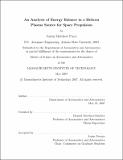An analysis of energy balance in a helicon plasma source for space propulsion
Author(s)
Pucci, Justin Matthew
DownloadFull printable version (24.09Mb)
Other Contributors
Massachusetts Institute of Technology. Dept. of Aeronautics and Astronautics.
Advisor
Manuel Martínez Sánchez.
Terms of use
Metadata
Show full item recordAbstract
This thesis covers work done on the mHTX@MIT helicon source as it relates to the analysis of power losses. A helicon plasma is a rather complex system with many potential loss mechanisms. Among the most dominant are optical radiation emission, wall losses due to poor magnetic confinement, and poor antenna-plasma coupling. This work sought to establish a first-order breakdown of the loss mechanisms in the mHTX@MIT helicon source so as to allow for a better understanding of the issues effecting efficiency. This thesis proposes the use of a novel thermocouple array, standard plasma diagnostics, and a simple global energy balance model of the system to determine greater details regarding the losses incurred during regular operation. From this it may be possible, by comparing the heat flux on the tube to the applied magnetic field profile, to gain some insight into the effects of magnetic field geometry on the character of the helicon discharge.
Description
Thesis (S.M.)--Massachusetts Institute of Technology, Dept. of Aeronautics and Astronautics, 2007. This electronic version was submitted by the student author. The certified thesis is available in the Institute Archives and Special Collections. Includes bibliographical references (p. 107-110).
Date issued
2007Department
Massachusetts Institute of Technology. Department of Aeronautics and AstronauticsPublisher
Massachusetts Institute of Technology
Keywords
Aeronautics and Astronautics.